 It was a good start to the day - a young male Sparrowhawk was one of the first birds in the nets and as usual it was a great crowd-pleaser.
It was a good start to the day - a young male Sparrowhawk was one of the first birds in the nets and as usual it was a great crowd-pleaser. The weather was pretty kind to us again today. Despite forecasts of blazing sun it remained overcast and with only the lightest breath of wind. As seems to have been the pattern over the last few years it has been a gorgeous September but there's no escaping the fact that the migrants are dwindling. Of our total of 64 birds, just under half were migrant warblers, all except two were Blackcaps and Chiffchaffs. Single late Reed and Willow Warblers were nice and you can test your Phylloscopus ID skills on the pic below. Answer further down...
The weather was pretty kind to us again today. Despite forecasts of blazing sun it remained overcast and with only the lightest breath of wind. As seems to have been the pattern over the last few years it has been a gorgeous September but there's no escaping the fact that the migrants are dwindling. Of our total of 64 birds, just under half were migrant warblers, all except two were Blackcaps and Chiffchaffs. Single late Reed and Willow Warblers were nice and you can test your Phylloscopus ID skills on the pic below. Answer further down... Of course there's no need to guess in the hand, particularly once you've inspected the wing formulae and these two were fairly typical individuals, even if the photo doesn't make it particularly easy to appreciate the overall shapes of the wings. Willows have longer, more pointed wings for migrating further (many reach South Africa) and Chiffs have shorter, rounder wings (don't cross the equator and often don't even leave Europe). Click on the picture to see a larger version.
Of course there's no need to guess in the hand, particularly once you've inspected the wing formulae and these two were fairly typical individuals, even if the photo doesn't make it particularly easy to appreciate the overall shapes of the wings. Willows have longer, more pointed wings for migrating further (many reach South Africa) and Chiffs have shorter, rounder wings (don't cross the equator and often don't even leave Europe). Click on the picture to see a larger version. Despite the attention to detail, once you've handled a few you can tell the difference fairly easily from an overall impression that seems to take into account a large number of different subtle features. On the pic below, look on the left at the Chiffchaff's slightly smaller, darker bill, more rounded head and less distinct supercilium which turns buff behind the eye and compare with the Willow on the right. On the first photo these features are not quite so obvious - and the birds are the other way round!
Despite the attention to detail, once you've handled a few you can tell the difference fairly easily from an overall impression that seems to take into account a large number of different subtle features. On the pic below, look on the left at the Chiffchaff's slightly smaller, darker bill, more rounded head and less distinct supercilium which turns buff behind the eye and compare with the Willow on the right. On the first photo these features are not quite so obvious - and the birds are the other way round! A few more Long-tailed Tits appeared today in amongst the resident birds that are making up an increasing proportion of the catch. Wildfowl and Meadow Pipits were obvious again, the former being flushed by a hot air balloon. The only hirundines today were 4 Swallows. The odd butterfly appeared (mostly Speckled Wood) and both Common Darter and Migrant Hawker emerged with the sun around midday. This is a Migrant Hawker - a female I think.
A few more Long-tailed Tits appeared today in amongst the resident birds that are making up an increasing proportion of the catch. Wildfowl and Meadow Pipits were obvious again, the former being flushed by a hot air balloon. The only hirundines today were 4 Swallows. The odd butterfly appeared (mostly Speckled Wood) and both Common Darter and Migrant Hawker emerged with the sun around midday. This is a Migrant Hawker - a female I think. Lastly, as we made our way out we came across this beauty:
Lastly, as we made our way out we came across this beauty: It's a Shaggy Ink Cap Coprinus comatus. So called because there is a smooth common species and as it releases its spores, the gills rapidly deliquesce into black fluid. Eventually the whole cap melts away, leaving just a spindly white stem. If you're feeling adventurous, it is edible.
It's a Shaggy Ink Cap Coprinus comatus. So called because there is a smooth common species and as it releases its spores, the gills rapidly deliquesce into black fluid. Eventually the whole cap melts away, leaving just a spindly white stem. If you're feeling adventurous, it is edible.Pete






























